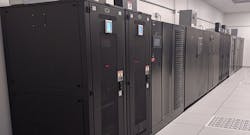Lithium-Ion Batteries Offer New Options for Data Center Backup Power
In this this edition of “Voices of the Industry,” Peter Panfil, Vice President of Global Power at Vertiv, explains the benefits of Lithium-ion batteries and how they can serve as a new alternative for data center backup power.
Mobile technologies have fundamentally changed our way of life – where and how we work, communicate and spend our time. Whether it’s the Super Bowl, the Academy Awards or election night, today’s experiences are completely different because our phones, tablets and laptops have enabled real-time, global conversations.
Peter Panfil, VP of Global Power, Vertiv
The chips and circuitry in these devices have evolved, become more powerful and continue to shrink, but the innovation that really removed the shackles and made it all mobile is the battery – specifically, the lithium-ion battery (LIB). It solved the problem of compact, light, long-lasting energy storage, and the applications are stretching far beyond cell phones and portable computers. The same benefits that make them so appealing for home electronics are valued in many different applications. We’re seeing them more and more in energy-gulping mechanical technologies such as automobiles, airplanes, military equipment and even golf carts, and more recently – the data center.
For decades, data center uninterruptible power supply systems (UPS) have predominantly relied on valve regulated lead acid (VRLA) batteries for backup transitional power. For the work they do, VRLA batteries themselves are relatively cost effective, but they are also big, heavy, don’t hold a charge as long as ideal and they require fairly frequent replacement. But they do what the UPS needs them to do – provide adequate power to cover the transition from grid to generator.
Increasingly, businesses are looking for alternatives to the good-enough but cumbersome VRLA. The same characteristics that make lithium-ion batteries such an appealing choice for electronics are driving a sea change of sorts in the data center. Industry innovators, such as Forsythe Data Centers near Chicago, have started using lithium-ion batteries with tremendous success – measured by cost savings, space savings and increased reliability.
The same characteristics that make lithium-ion batteries such an appealing choice for electronics are driving a sea change of sorts in the data center.
While Lithium-ion batteries are more expensive – about 1.75 times the price for VRLA, on average –Total Cost of Ownership (TCO) often favors lithium-ion. Let’s look at those advantages and quantify the differences.
- Reduced footprint: Lithium-ion batteries are about 70 percent smaller and 60 percent lighter than VRLA, significantly reducing the space required for battery storage. That can reduce construction costs on new builds or increase the amount of usable space in existing facilities. In some cases, lithium-ion batteries can even be stored in the row, reducing cable runs and simplifying monitoring and maintenance.
- Longer life: Lithium-ion batteries can last as much as four times as long as VRLA, and routinely last two-to-three times as long. The most significant cost associated with batteries is replacement. In most cases, VRLA batteries would need to be replaced multiple times before the first replacement of a lithium-ion battery.
- Reduced cooling costs: There are a number of variables that influence the cooling required for batteries and the associated costs, but some lithium-ion batteries can operate at higher temperatures than VRLA. In some cases, it can reduce battery cooling costs by as much as 70 percent.
So, why now?
Considering all of the advantages, why wasn’t lithium-ion used in the data center sooner?
There are a few forces at work. You can blame inertia – again, VRLA generally gets the job done, and is the de facto standard for companies considering lower first cost. But as more and more companies use TCO models to help them make their capital decisions, LIB is a compelling choice for many data centers. You can also credit advances in technology. Lithium-ion batteries have evolved and become more viable for data center deployments. New chemistries and construction practices have improved battery safety. Data center managers with images of laptop batteries bursting into flames now understand the lithium-ion batteries used with today’s UPS systems bear little resemblance to those early consumer models. These are safe, reliable alternatives to VRLA.[clickToTweet tweet=”Vertiv expects steady movement toward lithium-ion in data centers. ” quote=”We anticipate widespread acceptance and a steady movement toward lithium-ion in data centers around the world.”]
If you are considering a switch to Lithium Ion from VRLA batteries, be sure to check with your UPS manufacturer to make sure your UPS is compatible with Lithium Ion batteries. And remember that a proactive monitoring and maintenance program is important, regardless of what type of batteries are used.
As more and more early adopters report successful deployments, we anticipate widespread acceptance and a steady movement toward lithium-ion in data centers around the world.
Peter Panfil is the Vice President of Global Power at Vertiv, using more than 30 years of industry experience to lead global power sales for the Liebert AC Power business.
Vertiv designs, builds and services critical infrastructure that enables vital applications for data centers, communication networks, and commercial and industrial facilities. Formerly Emerson Network Power, Vertiv supports today’s growing mobile and cloud computing markets with a portfolio of power, thermal and infrastructure management solutions including the ASCO, Chloride, Liebert, NetSure and Trellis brands. Sales in fiscal 2016 were $4.4 billion. For more information, visit VertivCo.com.


